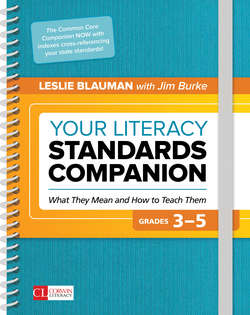Читать книгу Your Literacy Standards Companion, Grades 3-5 - Leslie Blauman - Страница 17
На сайте Литреса книга снята с продажи.
ОглавлениеCollege and Career Readiness Anchor Standards for Reading K–12
The College and Career Readiness (CCR) anchor standards are the same for K–12. The guiding principle here is that the core reading skills should not change as students advance; rather, the level at which they learn and can perform these skills should increase in complexity as students move from one grade to the next. However, for grades 3–5, we have to recognize that the standards were back mapped from the secondary grades—the authors envisioned what college students needed and then wrote standards, working their way down the grades. Thus, as you use this book remember that children in grades 3–5 can’t just “jump over” developmental milestones in an ambitious attempt toward an anchor standard. There are certain life and learning experiences they need to have, and certain concepts they need to learn, before they are capable of handling many complex academic skills in a meaningful way. The anchor standards nonetheless are goal posts to work toward. As you read the “gist” of the standards on the following pages, remember they represent what our 3–5 students will grow into during each year and deepen later in middle school and high school.
Key Ideas and Details
This first strand of reading standards emphasizes students’ ability to identify key ideas and themes in a text, whether literary, informational, primary, or foundational; whether print, graphic, quantitative, or mixed media. The focus of this first set of standards in on reading to understand, during which students focus on what the text says. The premise is that students cannot delve into the deeper (implicit) meaning of any text if they cannot first grasp the surface (explicit) meaning of that text. Beyond merely identifying these ideas, readers must learn to see how these ideas and themes, or the story’s characters and events, develop and evolve over the course of a text. Such reading demands that students know how to identify, evaluate, assess, and analyze the elements of a text for their importance, function, and meaning within the text.
Craft and Structure
The second set of standards builds on the first, focusing not on what the text says but how it says it, the emphasis here being on analyzing how texts are made to serve a function or achieve a purpose. These standards ask readers to examine the choices the author makes in terms of words, sentence, and paragraph structure and how these choices contribute to the meaning of the text and the author’s larger purpose. Inherent in the study of craft and structure is how these items interact with and influence the ideas and details outlined in the first three standards.
Integration of Knowledge and Ideas
This third strand might be summed up as: reading to extend or deepen one’s knowledge of a subject by comparing what a range of sources have said about it over time and across different media. In addition, these standards emphasize the importance of being able to read the arguments; that is, they look at how to identify the claims the texts make and evaluate the evidence used to support those claims regardless of the media. Finally, these standards ask students to analyze the choice of means and medium the author chooses and the effect those choices have on ideas and details. Thus, if a writer integrates words, images, and video in a mixed-media text, readers should be able to examine how and why the author did that in terms of stylistic and rhetorical purposes.
Range of Reading and Level of Text Complexity
The Common Core State Standards document itself offers the most useful explanation of what this last standard means in a footnote titled “Note of range and content of student reading,” which accompanies the reading standards:
To become college and career ready, students must grapple with works of exceptional craft and thought whose range extends across genres, cultures, and centuries. Such works offer profound insights into the human condition and serve as models for students’ own thinking and writing. Along with high-quality contemporary works, these texts should be chosen from among seminal U.S. documents, the classics of American literature, and the timeless dramas of Shakespeare. Through wide and deep reading of literature and literary nonfiction of steadily increasing sophistication, students gain a reservoir of literary and cultural knowledge, references, and images; the ability to evaluate intricate arguments; and the capacity to surmount the challenges posed by complex texts. (CCSS, 2010, p. 35)
Source: Adapted from Burke, J. (2013). The Common Core Companion: The Standards Decoded, Grades 6–8: What They Say, What They Mean, How to Teach Them. Thousand Oaks, CA: Corwin.
